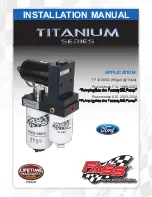
Gross Trailer Weight (GTW)
The GTW is the weight of the trailer plus the weight of
all cargo, consumables and equipment (permanent or
temporary) loaded in or on the trailer in its "loaded and
ready for operation" condition.
The recommended way to measure GTW is to put your
fully loaded trailer on a vehicle scale. The entire weight
of the trailer must be supported by the scale.
Gross Combination Weight Rating (GCWR)
The GCWR is the total permissible weight of your
vehicle and trailer when weighed in combination.
Gross Axle Weight Rating (GAWR)
The GAWR is the maximum capacity of the front and
rear axles. Distribute the load over the front and rear
axles evenly. Make sure that you do not exceed either
front or rear GAWR
WARNING!
It is important that you do not exceed the maximum
front or rear GAWR. A dangerous driving condition can
result if either rating is exceeded.
Tongue Weight (TW)
The TW is the downward force exerted on the hitch ball
by the trailer. You must consider this as part of the load
on your vehicle.
Frontal Area
The frontal area is the maximum height multiplied by
the maximum width of the front of a trailer.
Trailer Sway Control (TSC) – If Equipped
The TSC is a telescoping link that can be installed
between the hitch receiver and the trailer tongue. It
typically provides adjustable friction associated with the
telescoping motion to dampen any unwanted trailer
swaying motions while traveling.
Weight-Carrying Hitch
A weight-carrying hitch supports the trailer tongue
weight, just as if it were luggage located at a hitch ball
or some other connecting point of the vehicle. These
kinds of hitches are commonly used to tow small and
medium sized trailers.
Weight-Distributing Hitch
A Weight-Distributing Hitch works by applying leverage
through spring (load) bars. They are typically used for
heavier loads to distribute trailer tongue weight to the
tow vehicle's front axle and the trailer axle(s). When
used in accordance with the manufacturer's directions,
it provides for a more level ride, offering more consis-
tent steering and brake control thereby enhancing tow-
ing safety. The addition of a friction/hydraulic sway con-
trol also dampens sway caused by traffic and
crosswinds and contributes positively to tow vehicle and
trailer stability.
Trailer sway control and a Weight-Distributing (load
equalizing) Hitch are recommended for heavier Tongue
Weights (TW) and may be required depending on
vehicle and trailer configuration/loading to comply with
Gross Axle Weight Rating (GAWR) requirements.
WARNING!
•
An improperly adjusted Weight Distributing Hitch
system may reduce handling, stability, braking per-
formance, and could result in a collision.
•
Weight-Distributing Hitch Systems may not be com-
patible with surge brake couplers. Consult with
your hitch and trailer manufacturer or a reputable
Recreational Vehicle dealer for additional
information.
STARTING AND OPERATING
189
4
5538906_24_JL_OM_EN_USC_t_E1.pdf 189
5/22/2023 9:02:25 AM
















































